China has responded strongly to recent remarks by former U.S. President Donald Trump, who threatened to impose a new 10 percent tariff on countries aligned with the BRICS group. Trump made the statement on July 6 via a post on his Truth Social platform, warning that any nation siding with what he called “Anti-American policies of BRICS” would face the new tax—with no exceptions.
In response, the Chinese government defended the role and intentions of BRICS, emphasizing that it is not aimed at challenging or confronting any country. BRICS is an economic alliance originally made up of five major emerging economies: Brazil, Russia, India, China, and South Africa. In recent years, the group expanded to include Saudi Arabia, Egypt, the United Arab Emirates, Ethiopia, Indonesia, and Iran—bringing the total number of member nations to eleven.
At a press conference on July 7, Chinese Foreign Ministry spokesperson Mao Ning stated, “BRICS is an important platform for cooperation among developing countries. It promotes openness, inclusiveness, and voluntary cooperation. It is not a political or military alliance, and it does not target the United States or any other nation.”
Mao also addressed Trump’s renewed tariff threats, warning that such actions would only harm global trade. “China has made its position clear many times. Trade wars and tariff wars do not produce winners. Protectionism is not a sustainable strategy—it only leads to setbacks,” she said.
Trump’s message came as his self-imposed 90-day pause on reciprocal tariffs nears its end. He indicated that the U.S. may soon start issuing official tariff notices or announcing new trade agreements. While he did not give exact details, the post suggests the former president may be planning a tougher trade stance if he returns to power.
Trump has long criticized the BRICS alliance, viewing it as a threat to U.S. economic influence. The BRICS group, however, insists its purpose is to boost economic development and cooperation among emerging economies, not to form an anti-Western bloc. In recent years, the group has gained more visibility and influence by pushing for reforms in global financial institutions and encouraging trade in local currencies instead of the U.S. dollar.
Despite the tensions, China and the United States have recently made some progress in trade talks. The two countries reached a partial agreement that included the U.S. easing some trade restrictions and China increasing its exports of rare earth materials—key resources used in electronics and renewable energy products.
Still, experts warn that renewed trade tensions between the U.S. and China could have wide-ranging impacts. Tariffs on BRICS countries, many of which are major energy and resource suppliers, could lead to higher prices for raw materials and finished goods globally. It could also strain diplomatic relations not only between the U.S. and China but with other BRICS members as well.
In her remarks, Mao Ning reiterated China’s commitment to peaceful cooperation and urged the U.S. to take a more constructive approach. “Rather than imposing unilateral tariffs, we encourage dialogue and fair competition. The global economy needs stability, not confrontation,” she concluded.
As the global landscape continues to shift, the future of trade relations between major powers remains uncertain. Whether Trump’s latest threats will become policy or remain campaign rhetoric depends on upcoming political developments. But for now, China and the BRICS nations appear determined to stick to their path of cooperative development and open engagement with the rest of the world.


